W Tree (Symbol: WT)
EG30 | EG43 | EG78
Geology
Palaeogene (early to mid Tertiary) basaltic volcanic rocks. The basalts occupy an old abandoned valley that lies about 200 m above the valley of the present drainage system (Webb et al., 1991).
Landform
The rolling low hills of the W Tree map unit have an elevation range of about 450 to 650 m and a relief range of about 90 m. Slopes are generally less than 32% but steeper down the escarpment. The landform may also be described as a dissected plateau, mostly comprised of basalt, with the rocks below the basalt on the escarpment and above the dissected plateau being the Snowy River Volcanics.
It is arbitrarily separated from the Gelantipy map unit on the basis of its vegetation class, lower elevation and generally more hilly topography. The unit may be subdivided into three components: gentle to moderate slopes, crests and escarpments.
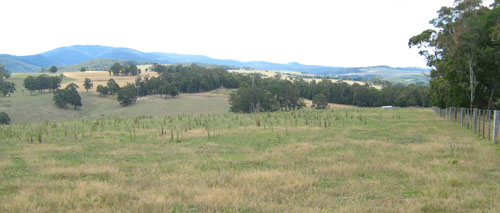
Rolling low hills of the W Tree map unit. Photo taken near W Tree looking north towards Gelantipy
Native vegetation
Valley grassy woodland.
Soils
Components 1 and 2: Soils on the gentle to moderate slopes and crests
The surface soils are mostly dark reddish brown clay loams, with minor occurrences of dark greyish brown clay loams. There is little colour change down the profile but there is an increase in clay content, generally to medium clay. In one of the soil profiles examined the free iron oxide content of the subsoil was above 5.0%. Even at this level of iron oxide the pH of the soil is sufficiently high to not adversely affect phosphorus fixation, a common problem with acidic soils high in free iron oxide. Throughout the profile the soils are slightly acidic and the nutrient holding capacity of the surface soils is moderate. The capacity of the soils to store water after rain depends on the depth to rock, but it is generally moderate to high. Basalt stones occur in many of the soil profiles.
Component 3: Soils on the escarpments
No soils were examined but it is likely that rock outcrops are common.
Land use
Apart from remnants of original vegetation, the land has been cleared and used for grazing or occasionally, horticulture. The soils have a favourable soil structure and are very permeable.
Site EG30
| Location: W Tree | Geo. Ref. 608700E 5864800N |
| Australian soil classification: Haplic, Eutrophic, Black DERMOSOL | Black gradational soil |
| General landscape description: Dissected plateau | |
| Geology: Tertiary basalt | |
| Site description: Upper hill-slope, W aspect 7% slope | |
| Land use: Grazing | |
| Native vegetation: Valley grassy forest | |
| Map unit: W Tree (Component 1) |
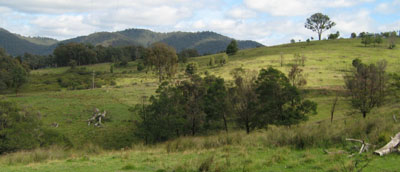
Soil profile morphology
| Surface soil | 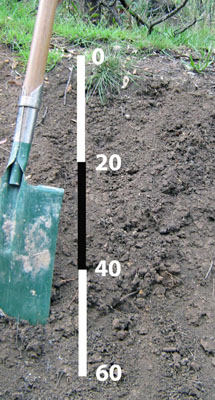 | ||
| A11 | 0 – 15 cm | Dark brown (10YR3/3); clay loam; moderate medium polyhedral structure; weak consistence moist; few (2 – 10%) sub-rounded basalt pebbles (2 – 20 mm); clear change to: | |
| A12 | 15 – 20 cm | Dark greyish brown (10YR4/2); clay loam; moderate medium polyhedral structure; weak consistence moist; few (2 – 10%) sub-rounded basalt pebbles (2 – 20 mm); clear change to: | |
| Subsoil | |||
| B1 | 20 – 30 cm | Very dark greyish brown (10YR3/2); light clay; moderate medium prismatic structure parting to medium polyhedral; very firm consistence moderately moist; few (2 - 10%) sub-rounded basalt pebbles (2 – 20 mm); gradual change to: | |
| B21 | 30 – 75 cm | Very dark greyish brown (2.5Y3/2); heavy clay; strong medium prismatic structure parting to medium polyhedral; very firm consistence moderately moist; few (2 – 10%) sub-rounded basalt pebbles (2 – 20 mm); gradual change to: | |
| B22 | 75 – 85+cm | Very dark greyish brown (2.5Y3/2); heavy clay; strong medium prismatic structure parting to medium polyhedral; very firm consistence moderately moist; many (20 – 50%) sub-rounded basalt fragments (2 – 20 mm) |
Key profile features
- Lack of strong texture contrast between the surface (A11 and A12) and subsoil (B1).
Soil profile characteristics
| pH | Salinity rating | Sodicity | Dispersion | Slaking | |
| Surface soil (A11 horizon) | Slightly acid | Low | Non sodic | None | Water stable |
| Subsoil (B1 horizon) | Slightly acid | Low | Non sodic | None | Water stable |
| Horizon | Depth cm | Field texture | pH water | pH CaCl2 | EC dS/m | Coarse sand % | Fine sand % | Silt % | Clay % | Field cap. % w/w | Wilt. point % w/w | PAW* water % w/w |
| A11 | 0-15 | CL | 6.9 | 6.3 | 0.12 | 14 | 31 | 16 | 24 | 41.1 | 24.1 | 17.0 |
| B1 | 20-30 | LC | 6.1 | 5.2 | 0.11 | 4 | 19 | 36 | 34 | 45.8 | 24.0 | 21.8 |
| B2 | 30-75 | HC | 6.6 | 5.7 | 0.09 | 20 | 11 | 14 | 54 | 49.7 | 29.7 | 20.0 |
| Depth | OrgC# | Total N | Free Fe2O3 | Exch. Al | Exchangeable cations cmol(+)/kg | Ca:Mg | ESP | ||||||
| cm | % | % | % w/w | ppm | Ca | Mg | K | Na | Total | H | CEC | ||
| 0-15 | 2.3 | 0.18 | 25 | 15 | 0.9 | 0.2 | 42 | 11 | 52 | 1.7 | 0 | ||
| 20-30 | 3.15 | 12 | 10 | 0.33 | 0.47 | 23 | 15 | 38 | 1.2 | 1 | |||
| 30-75 | 3.77 | 19 | 21 | 0.26 | 0.89 | 41 | 13 | 54 | 0.9 | 2 | |||
Management considerations
Whole profile
- The profile is slightly acid throughout.
- These soils are very well drained due to their strongly developed subsoil structure.
- Plant available water capacity is considered to be moderate to high (estimated at 108 mm) based on the laboratory data and an effective rooting depth of 100 cm.
- The soil has a low organic matter content. Organic matter will be better maintained under rotational grazing, which enables stronger pasture recovery, rather than set stocking.
- The nutrient holding capacity of the soil is high (based on the sum of the exchangeable basic cations).
- Although the soils are fairly high in iron oxide, the pH is high enough to minimise phosphorus fixation.
- Potassium levels are high and no response to potassium fertilisers would be expected.
- The friable nature of the subsoil allows deep penetration of plant roots.
- The friable nature of the subsoil, together with the shallow depth to rock, can lead to problems with sealing of earth dams.
| Location: Gelantipy | Geo. Ref. 612300E 5880200N |
| Australian soil classification: Haplic, Eutrophic, Red FERROSOL (Stony) | Stony red gradational soil |
| General landscape description: Dissected plateau | |
| Geology: Tertiary basalt | |
| Site description: Upper hill-slope, N aspect | |
| Land use: Grazing | |
| Native vegetation: Montane grassy woodland | |
| Map unit: W Tree (Component 1) |
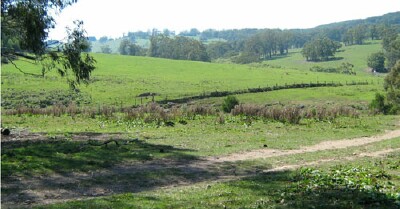
Soil profile morphology
| Surface soil | 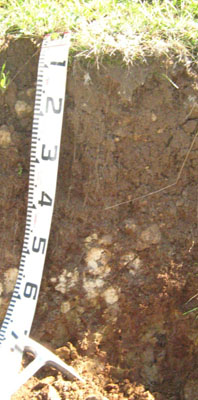 | ||
| A11 | 0 – 5 cm | Dark reddish brown (5YR3/2); loam; weak fine polyhedral structure; weak consistence moderately moist; few (2 – 10%) subangular basalt cobbles (2 – 200 mm); clear change to: | |
| A12 | 5– 30 cm | Reddish brown (5YR4/3); clay loam; moderate coarse (20 – 50 mm) polyhedral structure, parting to medium (10 - 20 mm) polyhedral structure; firm consistence dry; few (2 – 10%) subangular basalt cobbles (6 – 200 mm); clear change to: | |
| Subsoil | |||
| B | 30 – 60 cm | Dark reddish brown (2.5YR3/3); medium clay; coarse (20 – 50 mm) polyhedral structure parting to medium (10 - 20 mm) polyhedral structure; very firm moderately moist; common (10 – 20%) subangular basalt cobbles (6 – 200 mm). Weathering rock at 70 cm. | |
Key profile features
| |||
Soil profile characteristics
| pH | Salinity rating | Sodicity | Dispersion | Slaking | |
| Surface soil (A11 horizon) | Slightly acid | Very low | Non sodic | None | Slakes partially |
| Subsoil (B horizon) | Slightly acid | Very low | Non sodic | None | Slakes partially |
| Horizon | Depth cm | Field texture | pH water | pH CaCl2 | EC dS/m | Coarse sand % | Fine sand % | Silt % | Clay % | Field cap. % w/w | Wilt. point % w/w | PAW* water % w/w |
| A12 | 5-30 | CL | 6.2 | 5.5 | 0.07 | 13 | 34 | 32 | 22 | 28.4 | 10.3 | 18.1 |
| B | 30-60 | MC | 6.4 | 5.6 | 0.06 | 5 | 23 | 27 | 43 | 36.3 | 19.8 | 16.5 |
| Depth | OrgC# | Total N | Free Fe2O3 | Exch. Al | Exchangeable cations cmol(+)/kg | Ca:Mg | ESP | ||||||
| cm | % | % | % w/w | ppm | Ca | Mg | K | Na | Total | H | CEC | ||
| 5-30 | 1.4 | 0.9 | 3.4 | <1 | 5.7 | 3.2 | 1.2 | <0.05 | 10.1 | 7.8 | 17.8 | 1.8 | 0 |
| 30-60 | 5.1 | <1 | 9.3 | 7.0 | 1.5 | 0.07 | 17.9 | 11.0 | 29.0 | 1.4 | 0 | ||
Management considerations
Whole profile
- The profile is slightly acid throughout.
- These soils are very well drained due to their strongly developed subsoil structure.
- Plant available water capacity is considered to be low estimated at 70 mm based on the laboratory data, the presence of cobbles in the subsoil and the shallow nature of the soil profile.
- The immediate subsurface soil has low organic matter content. Organic matter will be better maintained under rotational grazing, which enables stronger pasture recovery, rather than set stocking.
- The nutrient holding capacity of the soil is moderate (based on the sum of the exchangeable basic cations).
- Although the soils are fairly high in iron oxide, the pH is high enough to minimise phosphorus fixation.
- Potassium levels are very high and no response to potassium fertilisers would be expected.
- The nature of the subsoil allows deep penetration of plant roots.
- The nature of the subsoil together with the shallow depth to rock, can lead to problems with sealing of earth dams.
| Location: W Tree | Geo. Ref. 608700E 5864800N |
| Australian soil classification: Melanic, Eutrophic, Red FERROSOL | Red gradational soil |
| General landscape description: Plateau | |
| Geology: Tertiary basalt | |
| Site description: Lower slope, 2% slope | |
| Land use: Grazing | |
| Native vegetation: Valley grassy woodland | |
| Map unit: W Tree (Component 1, crest) |
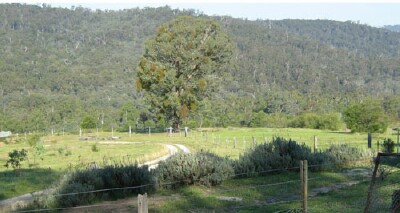
The steep wooded hills in the background are mapped as the Carrabungla map unit.
Soil profile morphology
| Surface soil | 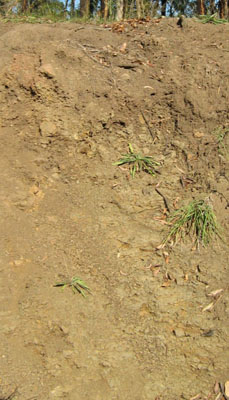 | ||
| A | 0 – 35 cm | Dark reddish brown (5YR3/2); clay loam; strong medium polyhedral structure, parting to very fine polyhedral structure; weak consistence moderately moist; clear change to: | |
| Subsoil | |||
| B2 | 35 - 55+cm | Dark reddish brown (2.5YR3/4); medium clay; strong coarse polyhedral parting to fine polyhedral structure; firm consistence moist | |
Key profile features
| |||
Soil profile characteristics
| pH | Salinity rating | Sodicity | Dispersion | Slaking | |
| Surface soil (A horizon) | Slightly acid | Very low | Non sodic | None | Slakes partially |
| Subsoil (B2 horizon) | Slightly acid | Very low | Non sodic | None | Slakes partially |
| Horizon | Depth cm | Field texture | pH water | pH CaCl2 | EC dS/m | Coarse sand % | Fine sand % | Silt % | Clay % | Field cap. % w/w | Wilt. point % w/w | PAW* water % w/w |
| A | 0-35 | CL | 6.2 | 5.2 | <0.05 | 7 | 22 | 27 | 34 | 42.4 | 17.9 | 24.5 |
| B2 | 35-55 | HC | 6.2 | 5.3 | <0.05 | 4 | 14 | 16 | 63 | 43.5 | 29.3 | 14.2 |
| Depth | OrgC# | Total N | Free Fe2O3 | Exch. Al | Exchangeable cations cmol(+)/kg | Ca:Mg | ESP | ||||||
| cm | % | % | % w/w | ppm | Ca | Mg | K | Na | Total | H | CEC | ||
| 0-35 | 4.0 | 0.26 | 6.1 | <1 | 9.2 | 4.2 | 0.92 | 0.19 | 14.5 | 19.0 | 34.4 | 2.2 | 1 |
| 35-55 | 8.1 | <1 | 6.7 | 4.5 | 0.48 | 0.23 | 11.9 | 13.0 | 24.9 | 1.5 | 1 | ||
Management considerations
Whole profile
- The profile is slightly acid throughout.
- These soils are very well drained due to their strongly developed subsoil structure.
- There is little restriction to roots throughout the profile.
- Plant available water capacity is considered to be high; estimated at 130+ mm, based on the laboratory data and the depth of soil available to plant roots.
- The nutrient holding capacity of the soil is moderate (based on the sum of the exchangeable cations).
- The soils are high in iron oxide, but the pH is probably high enough to minimise phosphorus fixation.
- Potassium levels are high.
- The friable nature of the subsoil allows very deep penetration of plant roots.
- The friable nature of the subsoil can lead to problems with sealing of earth dams.


